In this month’s investment view I’ll review 2019 for Evenlode Income and briefly discuss my thoughts on the outlook. I’ve also included a summary of the fourth quarter as an appendix for those interested.
It’s been a relatively quiet start to 2020 so far, with Evenlode Income up +1.3% and the UK market +1.2%*. The full year results season is commencing with lots of company updates due over the next few weeks. I’ll discuss some key themes that we’re hearing from the corporate world in February’s investment view.
From Pessimism to Optimism
At the beginning of 2019, investor sentiment was quite negative with worries over rising interest rate rises, trade tariffs, the global economy and Brexit. This had caused a significant sell-off in most stock markets at the end of 2018 and was beginning to create a valuation environment that we felt was as interesting as it had been for three or four years. Since then sentiment has, quite sharply, swung towards optimism. Though the global economy did slow during the year, it’s just about muddled along, and perhaps most significantly for financial assets, monetary policy was eased. Towards the end of the year better news on US/China trade tariffs and more clarity on the UK’s political situation also helped. This meant 2019 ended up being a strong year for most global stock markets.
A Long-Term Approach
Evenlode Income returned 24.3% during the year compared to 19.2% for the FTSE All-Share. With another calendar year added to Evenlode Income’s life, below are both the fund’s year-by-year and cumulative total returns versus its benchmark, the FTSE All-Share, to 31st December 2019**.
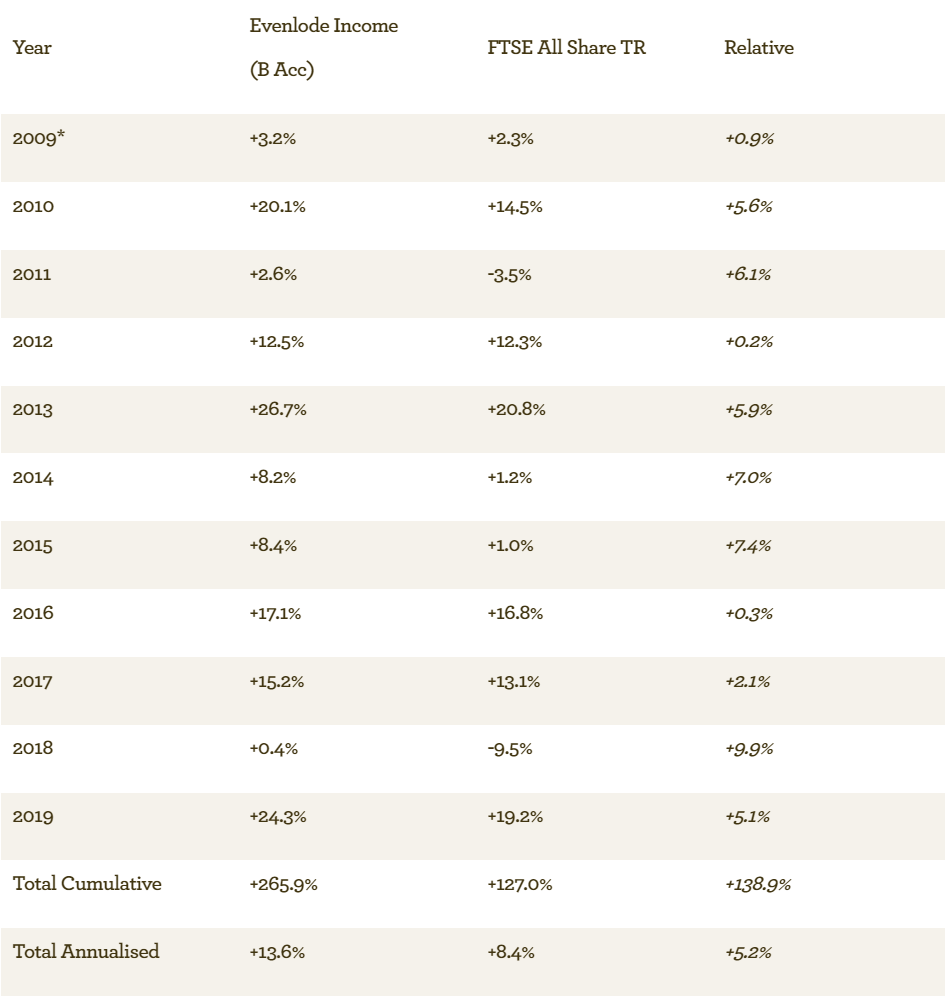
As we have said before, all the numbers in the second and last columns happen to be positive, but this will not always be the case, and in fact hasn’t been for several twelve-month periods that happened not to coincide with a calendar year. Our focus on competitively advantaged, asset-light companies results in a portfolio that looks very different to the UK market. We think this approach is well placed to achieve real dividend growth and attractive total returns over the long-term. But over shorter time periods, there will be certain markets (for instance, when resources and financials shares are sharply outperforming) where this is unlikely to be the case. To illustrate this point, the below chart shows the fund’s relative return since launch, by quarter, compared to the FTSE All-Share**.
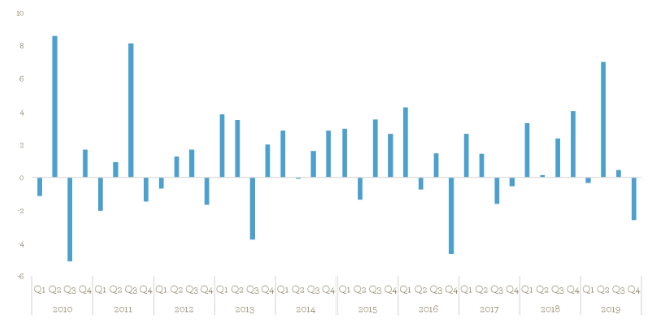
Performance Drivers and Portfolio Changes
The tables below show the most positive and negative contributors to the fund’s performance for the year***:
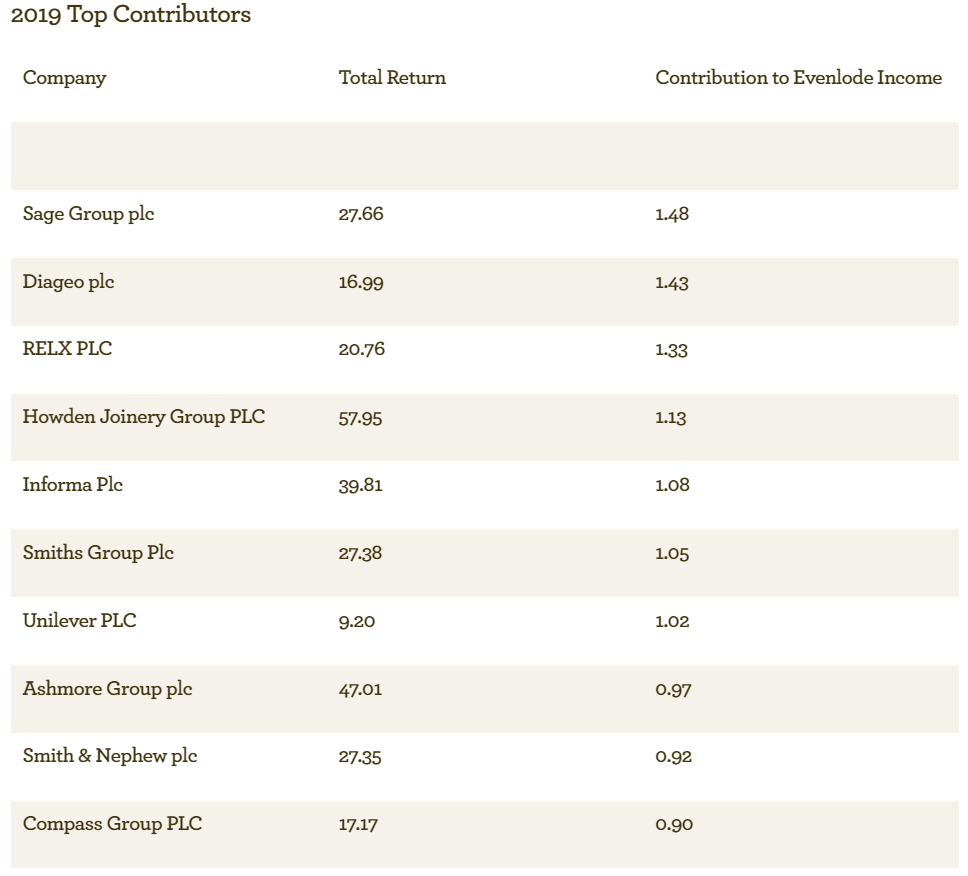
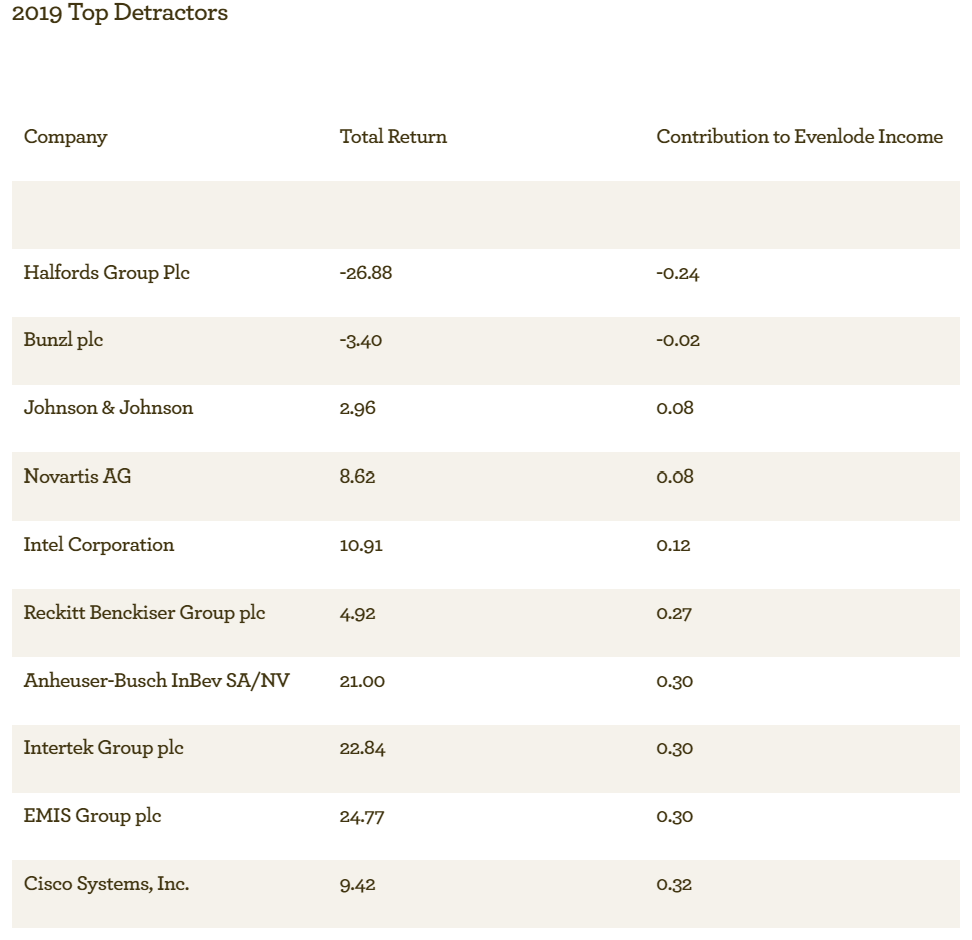
A combination of strong market conditions and solid fundamental progress helped almost all of the fund’s holdings to post a positive return. Sage was the strongest contributor to return (having been the most negative contributor in 2019). The company made good progress on new management’s strategy to accelerate the business model’s transition to software subscription and the cloud. Recurring revenues grew more than +10% during the company’s latest financial year and recurring revenues now account for 86% of overall sales. There were two negative contributors to the fund’s return during the year. Halfords was impacted by the difficult UK retail environment and management’s decision to step up investment levels to drive the company’s shift to a more service-orientated business model. Bunzl was a new position in May which I discuss below.
In terms of the fund’s relative performance against the FTSE All-Share, it was a game of two halves (or more accurately a game of two thirds and one third) with a clear inflection point at the end of August. In the first eight months (and particularly during the summer) the fund outperformed. During this period the pound was falling, interest rate expectations were reducing significantly, and worries were emerging over both the global and UK economy. Stable, multinational earners were therefore favoured by investors, and helped drive the fund’s performance. We made some fairly significant reductions to several of the strongest performing holdings over the summer including Diageo, Compass, Smith & Nephew, Cisco, Microsoft and Burberry. We also exited healthcare holdings Novartis and Johnson & Johnson in March and engineering software firm Aveva in May. All these changes were made for valuation reasons. In terms of additions, we continued to add to several stocks that had underperformed in the second half of 2018. This included companies such as Howden Joinery, Hays, Page Group and Moneysupermarket. Their shares had been tarred with the Brexit brush but we felt long-term prospects and valuations were attractive. We also added to several holdings whose economic sensitivity had made them unfashionable such as WPP, Smiths Group and Spectris. Elsewhere we saw opportunities to add to some repeat-purchase franchises such as Reckitt and Informa, and added new positions in Intertek (March) and Bunzl (May). Intertek and Bunzl are both market-leading businesses with interesting structural growth prospects and business models with attractive economics. However, short-term headwinds had led their shares to retreat.
Then, at the end of August, there was a reversal of the key performance trends mentioned above and the fund lagged the market. In particular, the pound rallied strongly, more economically sensitive shares performed well, and large stable multinationals fell out of favour. We have made relatively few portfolio changes, but over the last few weeks we have begun topping up several larger, stable, high quality businesses that have fallen out of fashion as investors look to take on more risk. Examples include Unilever, Bunzl and Cisco. These companies’ share prices have all fallen more than 20% from the highest points they reached last year. We also added a new holding in Intel to the portfolio in October. For more discussion on performance drivers and changes to the portfolio in the last three months of the year, please see the fourth quarter review in the appendix to this piece.
Outlook
The outlook for 2020 is, as normal, complex. Sentiment has improved materially towards the outlook for both the UK and global economy during 2019. However, UK political uncertainties remain, global geopolitical risk is elevated, global deflationary pressures persist, and valuations are not as attractive as they were a year ago.
We will continue to invest with a mindset that focuses on long-term potential whilst managing valuation, fundamental risk and diversification along the way. The underlying portfolio’s holdings continue to make good progress and generate healthy levels of cash from strong balance sheets, as shown in the table below****:
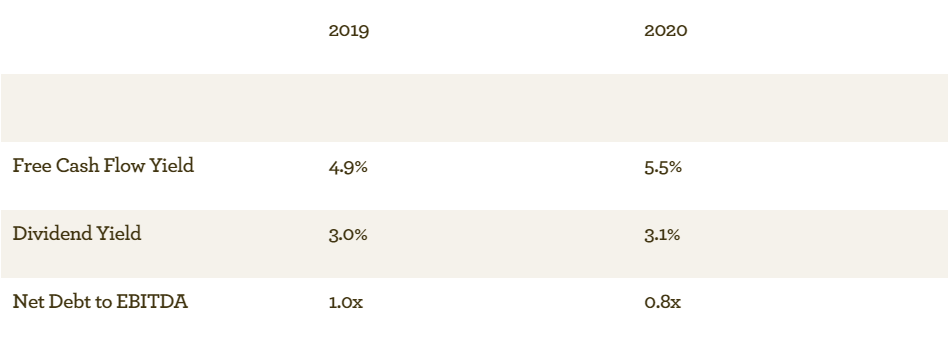
Recent market moves are allowing us to add to several holdings at more attractive valuations, and we remain open to evolving the portfolio as and when interesting opportunities present themselves.
We look forward to updating you on Evenlode Income’s progress over the coming year. As always, please do get in touch if you have any queries.
Hugh and the Evenlode Team
20 January 2020
Please note, these views represent the opinions of Hugh Yarrow as at 20 January 2020 and do not constitute investment advice.
*Source: Evenlode, Financial Express, total return, bid-to-bid, 31/12/2019 to 20/01/2020.
**Source: Evenlode, Morningstar.
***Source: Evenlode, FactSet, all data to 31/12/2019.
****Source: Evenlode, FactSet consensus estimates, as at January 2020.
Appendix: Fourth Quarter Review
The last quarter of 2019 was a positive one for the UK stock market. Evenlode Income rose +1.6% compared to +4.2% for the FTSE All Share. The most significant dynamic in the UK market was domestic politics. In October there was an increased expectation that a successful EU withdrawal agreement would be reached and in December the election of a Conservative majority government reduced political uncertainty. This led to a continued rally in the pound and a mixed performance amongst individual shares. In general, the shares of more domestically focused companies outperformed their multi-national peers, a reversal of trends seen over the summer months. The top contributors and detractors to the fund over the quarter clearly illustrate these trends***:
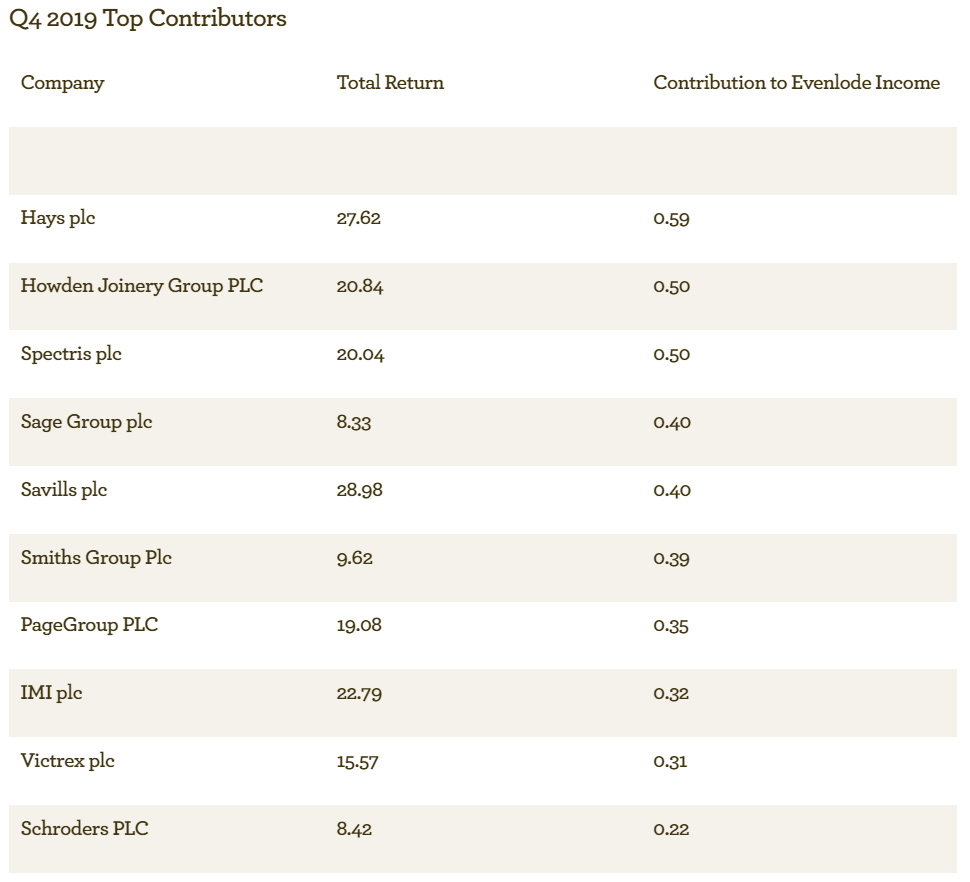
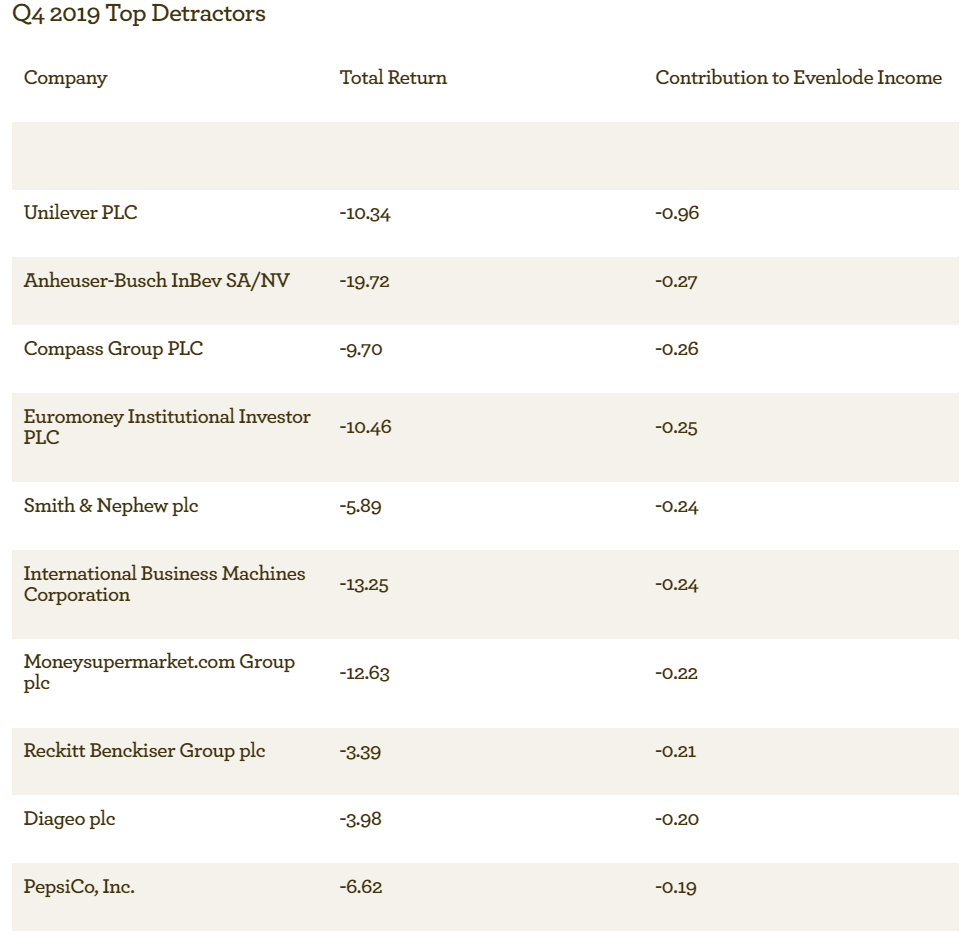
The main negative contributor of note was Unilever. Shares fell over -10% during the period and in December management announced that organic sales growth for 2019 will be slightly below the company’s +3-4% guidance range. Unilever is currently facing some challenges in certain markets and categories, but is taking steps to address them. For the patient shareholder, we think the combination of diversification, stability, cash generation and growth potential remains attractive. Following the recent share price fall, Unilever’s current dividend yield is approximately 3.4%. Other global multinational companies such as Compass, Reckitt, Diageo and AB Inbev also experienced share price weakness during the quarter. Some of the fund’s most positive contributors included Spectris, Hays, Howden Joinery, Savills and IMI whose share prices all rose by around 20% and benefited from the renewed interest in UK domestic mid cap names for reasons discussed above.
We added only one new holding in Intel to the portfolio. The company has a strong economic moat, a culture of innovation and, in our view, good structural growth prospects. Intel’s dividend yield was approximately 2.5% at initiation and is well underpinned by its healthy, growing free cash flow stream. There were no exits during the period.